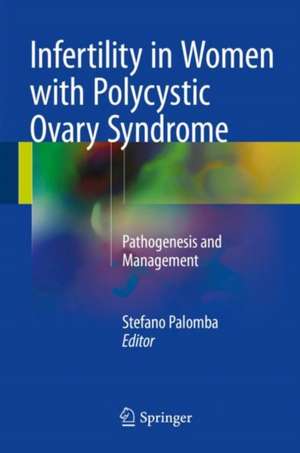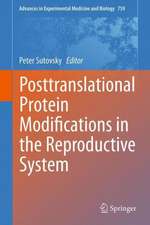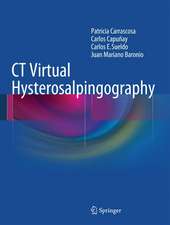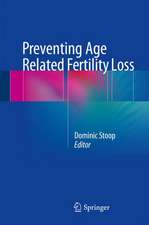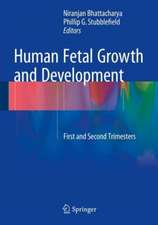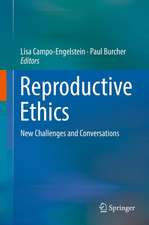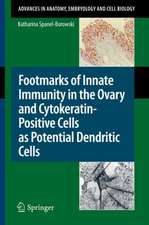Infertility in Women with Polycystic Ovary Syndrome: Pathogenesis and Management
Editat de Stefano Palombaen Limba Engleză Hardback – 13 feb 2018
| Toate formatele și edițiile | Preț | Express |
|---|---|---|
| Paperback (1) | 592.49 lei 38-44 zile | |
| Springer International Publishing – 6 iun 2019 | 592.49 lei 38-44 zile | |
| Hardback (1) | 854.16 lei 38-44 zile | |
| Springer International Publishing – 13 feb 2018 | 854.16 lei 38-44 zile |
Preț: 854.16 lei
Preț vechi: 899.12 lei
-5% Nou
Puncte Express: 1281
Preț estimativ în valută:
163.46€ • 177.50$ • 137.31£
163.46€ • 177.50$ • 137.31£
Carte tipărită la comandă
Livrare economică 18-24 aprilie
Preluare comenzi: 021 569.72.76
Specificații
ISBN-13: 9783319455334
ISBN-10: 3319455338
Pagini: 359
Ilustrații: XIII, 337 p. 40 illus., 28 illus. in color.
Dimensiuni: 155 x 235 mm
Greutate: 0.7 kg
Ediția:1st ed. 2018
Editura: Springer International Publishing
Colecția Springer
Locul publicării:Cham, Switzerland
ISBN-10: 3319455338
Pagini: 359
Ilustrații: XIII, 337 p. 40 illus., 28 illus. in color.
Dimensiuni: 155 x 235 mm
Greutate: 0.7 kg
Ediția:1st ed. 2018
Editura: Springer International Publishing
Colecția Springer
Locul publicării:Cham, Switzerland
Cuprins
Part I: Diagnosis, Pathophysiology, and Pathogenesis.- Introduction .- Diagnostic criteria for PCOS.- Anovulation in women with PCOS.- Oocyte quality in PCOS.- Endometrium in PCOS.- Infertility and subfertility cofactors in women with PCOS.- PCOS phenotypes: impact on fertility.- Part II: Management.- Lifestyle interventions and natural and assisted reproduction in women with PCOS.- Antiestrogens.- Aromatase inhibitors.- Insulin sensitizing drugs.- Gonadotropins.- Laparoscopic ovarian drilling.- Inositols.- Dietary supplements and phytotherapy.- Acupuncture.- Controlled ovarian stimulation for intrauterine insemination cycles.- Controlled ovarian stimulation for in vitro fertilization cycles.- In vitro oocyte maturation .- Integrated strategies for enhancement of fertility .- Managing complications in pregnancy .- Part III: Outlook and Conclusion.- Future perspectives.- Conclusion.
Notă biografică
Stefano Palomba is a Full Professor of Obstetrics and Gynecology who works in the Obstetrics and Gynecology Unit of the Department of Obstetrics, Gynecology, and Pediatrics, Azienda Ospedaliera ASMN, Istituto di Ricovero e Cura a Carattere Scientifico of Reggio Emilia, Italy. Dr. Palomba is responsible for training and research in the department and undertakes research in the fields of Gynecologic Endocrinology and Minimally Invasive Gynecology. He has published about 250 scientific articles in leading international journals and is Editor-in-Chief of the Journal of Ovarian Research and Associate Editor of Human Reproduction and also acts as a reviewer for several other international scientific journals.
Textul de pe ultima copertă
This book presents up-to-date knowledge on infertility in the context of polycystic ovary syndrome (PCOS) and provides clear evidence-based guidance on its treatment. The book opens by discussing anovulation, oocyte quality, and the endometrium in women with PCOS, infertility and subfertility cofactors, and the impact of PCOS phenotypes on fertility. All aspects of management are then thoroughly addressed. The available medical treatments for PCOS-related infertility – including antiestrogens, aromatase inhibitors, insulin-sensitizing drugs, and gonadotropins – are reviewed, and other potential therapeutic approaches, such as acupuncture and laparoscopic ovarian drilling, are assessed. Careful attention is also devoted to the role of lifestyle interventions. The use of controlled ovarian stimulation in infertile PCOS patients undergoing intrauterine insemination or in vitro fertilization is examined in detail, as are the benefits of in vitro maturation of oocytes. This book will beof value to all who are involved in the care of women with PCOS and related infertility issues.
Caracteristici
Provides evidence-based guidance on the management of infertility in women with PCOS Covers all available treatment options Discusses the role of controlled ovarian stimulation and in vitro oocyte maturation Presents the latest knowledge on pathogenesis
